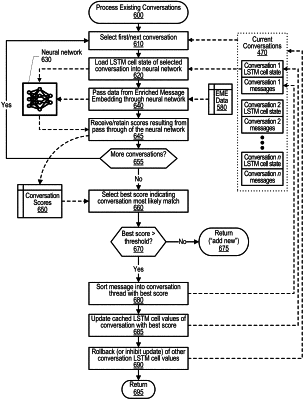| CPC H04L 51/216 (2022.05) [G06N 3/044 (2023.01); G06N 3/08 (2013.01)] | 5 Claims |

|
1. A method implemented by an information handling system that includes a processor and a memory accessible by the processor, the method comprising:
receiving a first message and a second message;
applying a deep analytic analysis to the received messages to form a first set and a second set of enriched message embedding (EME) data;
processing each conversation included in a plurality of conversations, wherein, when selected, each of the conversations is processed by a trained neural network by:
loading a set of cell states in the neural network with a set of previously saved cell states that correspond to the selected conversation;
passing the first and second sets of EME data to the trained neural network;
receiving a first set of scores from the trained neural network that indicates an affinity of the selected conversation to the received first message and a second set of scores from the trained neural network that indicates an affinity of the selected conversation to the received second message;
identifying, based on comparing a threshold to the first and second sets of scores, one of the conversations to which the received first message belongs;
associating the received first message with the identified conversation;
comparing a best score from the second set of one or more scores to the threshold, wherein the determination that the second message belongs to any of the plurality of conversations is based on the best score failing to reach the threshold;
creating a new conversation that is added to the plurality of conversations upon determination that the second message does not belong to any of the plurality of conversations; and
associating the received second message with the new conversation.
|